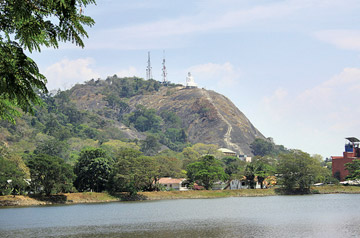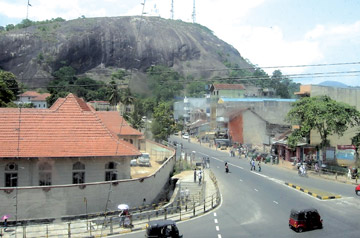Kurunegala is named after Elephant Rock
Kurune means tusker or an elephant with protruding teeth and Gala in
Sinhala means rock. Kurunegala's old name was Hasthishailya-pura, which
can be translated as 'The city of the Elephant rock'.
 In
some ancient literature the word Athugal-pura is also used to describe
the city of Kurunegala. Nearby are three archaeological cities such as
Parakramapura (Panduvasnuwara) (north-west) with ruins of a moated
palace and monasteries from the 12th century, (Dambadeniya) (south -
west, mid-13th century) and Yapahuwa (north). In
some ancient literature the word Athugal-pura is also used to describe
the city of Kurunegala. Nearby are three archaeological cities such as
Parakramapura (Panduvasnuwara) (north-west) with ruins of a moated
palace and monasteries from the 12th century, (Dambadeniya) (south -
west, mid-13th century) and Yapahuwa (north).
It enjoys a pleasant location overlooked by huge rocky outcrops some
of which have been given names of the animals they resemble such as
Elephant rock and Tortoise rock. According to folklore, a long time ago
the city experienced a severe drought.
To exacerbate matters for humans, animals had threatened the city's
storage capabilities by consuming huge amounts of water. Fortunately for
the people, a witch had volunteered to alleviate the problem,
transforming some of the animals magically into stone figures. This is
how the stony outcrops in Kurunegala derived their names.
Geography and the climate
Topographically, Kurunegala town is based on a plain area with the
exception of the surrounding rock outcrops. The northern part of the
town is slightly higher than the south. The Kurunegala Lake adorns the
town. The Kurunegala area is located well above sea level compared to
the Sri Lankan coastal areas.
 However,
the area is not as high as the central hill country of the island. The
nearest beaches to Kurunegala are to the western coastal areas and
include Meegamuwa (Negombo)and Halawatha (Chilaw). However,
the area is not as high as the central hill country of the island. The
nearest beaches to Kurunegala are to the western coastal areas and
include Meegamuwa (Negombo)and Halawatha (Chilaw).
Climate
Kurunegala's climate is fairly temperate and tropical all throughout
the year. However, during April the temperature can rise up to about 35
degrees Celsius (95 degrees Fahrenheit). The only major change in the
Kurunegala weather occurs during the monsoons from May to August and
October to January.
This is the time when heavy rains can be expected. In general,
temperatures experienced during late November to mid February are lower
than the rest of the year.
Kurunegala had a citadel in the 13th century. Kurunegala was the
capital for half a century, starting with the reign of King Buvanekabahu
II (1293-1302) who was followed by King Parakramabahu IV (1302-1326).
Some ruins of the Palace of the Tooth Relic that housed the tooth of
the Buddha can be seen today. The present Palace of the Tooth relic is
situated in Senkadagala/Mahanuwara.
- Internet
|

